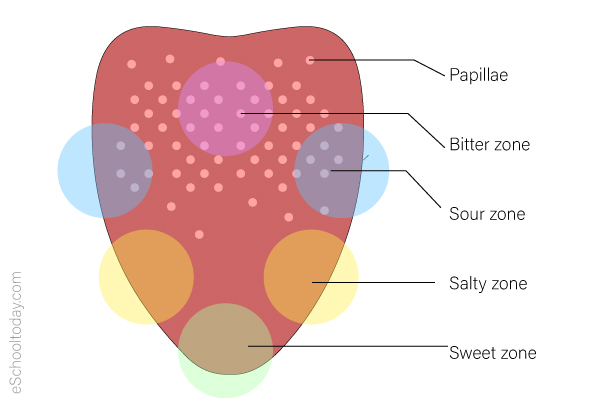- The Five Senses
The Tongue and the Sense of Taste
Gustation (another term for taste) is another of our five senses that help us differentiate the chemicals that make up food. The organ for taste is the tongue. Take a close look at your tongue in a mirror and you will notice that it has a very rough, gross texture.
Below is a diagram of the tongue showing taste zones.

The entire gustatory system is composed of the tongue, the papillae, taste buds, and receptor cells. The surface of the tongue is made up of about ten thousand taste buds, found on the papillae (the tiny bumps on the tongue). Each taste bud has about 100 receptor cells.
Our taste buds detect only five chemical stimuli: sweet, bitter, sour, salty, and umami (salts of certain acids that are associated with savory flavors). This ability of the tongue to taste these five distinctive chemicals helps us to maintain a balance in our bodies, as well as prevent us from taking in toxic substances. How does this work?
When a food item enters the mouth, the tongue receives it. Before it goes down your throat, it is dissolved in saliva and that slips into all the tiny pores and grooves on the tongue. Here, special nerve fibers located on the receptor cells are stimulated. They pick up the impulses in the food and quickly send that signal to the brain for interpretation.
Scientists believe that the sense of smell has a profound impact on the sense of taste.
Some of our reading and research included the materials below
1. Sensing Our Five Senses, by Carol Boynton. http://teachers.yale.edu/curriculum/viewer/initiative_09.06.02_u
2. The Physiology of the Senses, Transformations For Perception and Action., http://www.saylor.org/site/wp-content/uploads/2010/11/OntarioU-Hearing.pdf
3. The Basis of the Physiology of Sensation, http://physiologyofsensationandperception.wikispaces.com/Key+Findings
4. Eye Anatomy and Function. Experiment: Peripheral vision. Developed by Marjorie A. Murray, Ph.D.; Neuroscience for Kids Staff Writer.https://faculty.washington.edu/chudler/eyetr.html
5. The Five Senses – Lesson 6: Taste, http://www.sedl.org/scimath/pasopartners/senses/lesson6.html
6. How the body works. http://kidshealth.org/kid/htbw/
7. Investigating your Sense of Sight, http://www.abc.net.au/science/surfingscientist/pdf/lesson_3_eyesight_student_worksheet.pdf
8. Touching, Thinking, Being: The Sense of Touch in Aristotle’s De anima and Its Implications Pascal Massie, http://www.minerva.mic.ul.ie/Vol17/Touching%20.pdf
